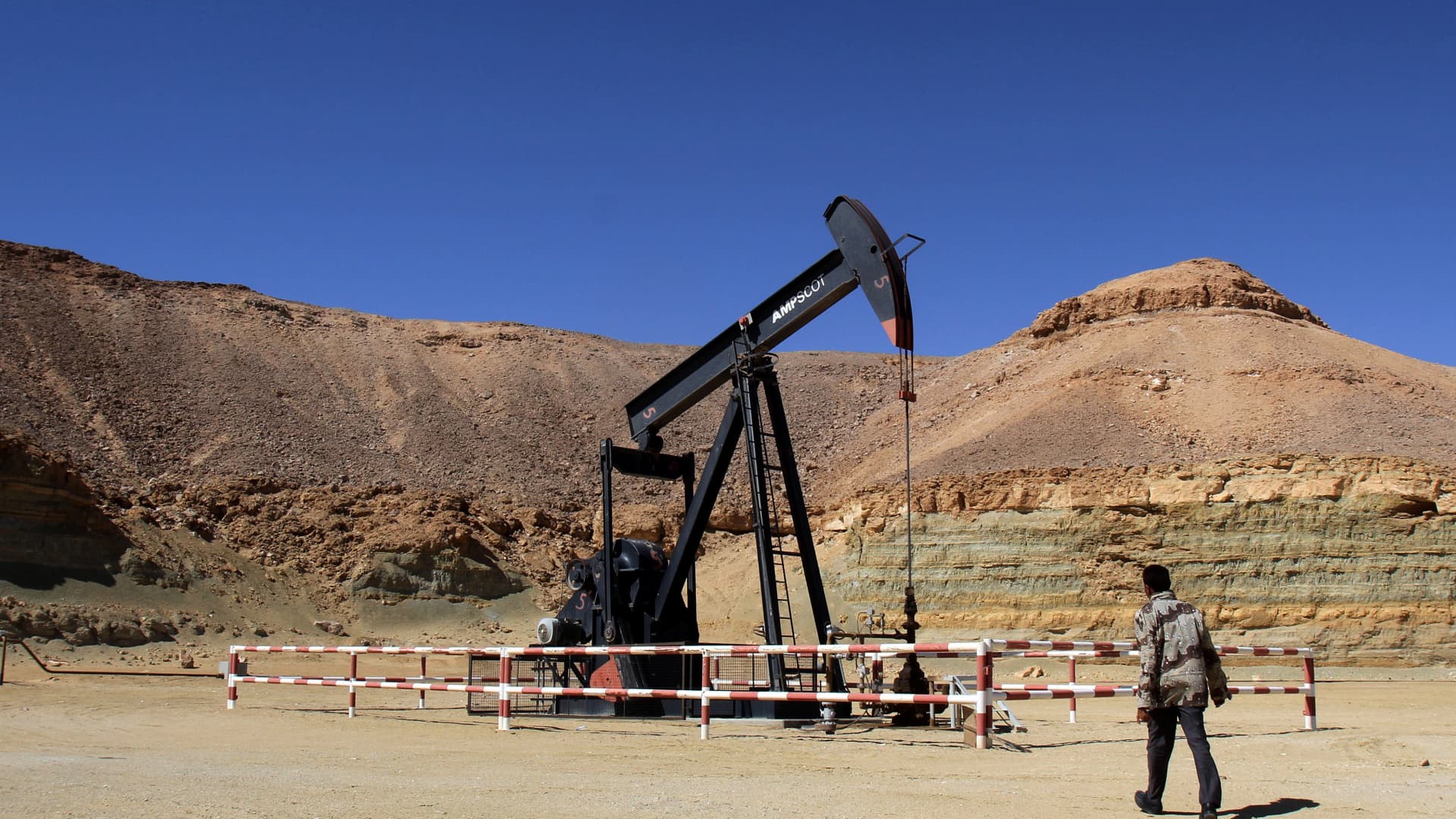

Finance
How To Invest In Natural Gas Stocks
Published: January 17, 2024
Learn how to invest in natural gas stocks and make informed financial decisions. Discover strategies and tips to maximize your returns in the finance industry.
(Many of the links in this article redirect to a specific reviewed product. Your purchase of these products through affiliate links helps to generate commission for LiveWell, at no extra cost. Learn more)
Table of Contents
- Introduction
- Understanding the Natural Gas Industry
- Benefits and Risks of Investing in Natural Gas Stocks
- Factors to Consider Before Investing
- Researching Natural Gas Companies
- Evaluating Financial Performance
- Analyzing Natural Gas Market Trends
- Diversifying Your Portfolio with Natural Gas Stocks
- Strategies for Investing in Natural Gas Stocks
- Conclusion
Introduction
Investing in the stock market can be a lucrative way to grow your wealth, but with so many options available, it’s important to consider all the possibilities. One sector that has gained significant attention in recent years is natural gas stocks.
Natural gas is a fossil fuel that is used for a variety of purposes, including heating, electricity generation, and as a feedstock in chemical manufacturing. As the world strives to find cleaner and more sustainable energy sources, natural gas has emerged as a transitional fuel that emits less carbon dioxide than other fossil fuels like coal and oil.
Investing in natural gas stocks can be an attractive opportunity for both short-term traders and long-term investors. Not only does the demand for natural gas continue to grow, but advancements in technology have made it easier and more cost-effective to extract this valuable resource.
However, it’s important to note that investing in natural gas stocks also comes with its own set of risks. Market volatility, fluctuating global energy prices, regulatory changes, and environmental concerns are just a few factors that can impact the performance of natural gas stocks.
In this article, we will delve into the world of natural gas stocks and explore the benefits and risks associated with investing in this sector. We will also provide key factors to consider before making an investment, guidance on researching and evaluating natural gas companies, strategies for diversifying your portfolio with natural gas stocks, and more.
By the end of this article, you will have a solid understanding of how to invest in natural gas stocks and be equipped with the necessary knowledge to make informed investment decisions in this dynamic market.
Understanding the Natural Gas Industry
The natural gas industry is a crucial component of the global energy sector. It involves the exploration, extraction, production, transportation, and distribution of natural gas resources. Understanding the key players and dynamics of this industry is essential for any investor looking to venture into natural gas stocks.
One of the primary sources of natural gas is found in underground rock formations known as reservoirs. These reservoirs can be located on land or offshore, and accessing the natural gas typically involves drilling wells to extract it. Exploration companies employ advanced technologies and geological expertise to identify potential natural gas reserves.
Once a reservoir is discovered, production companies take over, using various methods such as hydraulic fracturing (fracking) or conventional drilling to extract the natural gas. The extracted gas is then processed to remove impurities, such as water and other gases, before being transported to users via pipelines or as liquefied natural gas (LNG) through specialized vessels.
The natural gas industry is highly interconnected with other sectors, including utilities, manufacturing, and transportation. Natural gas is used extensively for electricity generation, providing a cleaner alternative to coal-fired power plants. It is also a vital energy source for residential heating, industrial processes, and as a fuel for vehicles.
Global demand for natural gas has seen steady growth in recent years, driven by factors such as population growth, urbanization, and increasing industrialization. Additionally, governments and industries around the world are increasingly recognizing the environmental advantages of natural gas compared to other fossil fuels, leading to a surge in demand for cleaner energy sources.
When considering investing in natural gas stocks, it’s important to understand the various segments of the industry. These include upstream companies involved in exploration and production, midstream companies focused on transportation and storage, and downstream companies that distribute and market natural gas to end-users.
Furthermore, it’s essential to keep an eye on regulatory policies and geopolitical factors that can influence the natural gas industry. Changes in regulations, tax incentives, environmental standards, and trade agreements can all impact the profitability and prospects of natural gas companies.
By gaining a comprehensive understanding of the natural gas industry, investors can make informed decisions regarding which companies to invest in and how to anticipate and navigate potential industry shifts.
Benefits and Risks of Investing in Natural Gas Stocks
Investing in natural gas stocks can offer several potential benefits, but it’s essential to weigh them against the risks involved. Understanding both the advantages and challenges associated with investing in natural gas stocks is crucial for making informed investment decisions.
Benefits:
1. Increasing Demand: The demand for natural gas has been on the rise due to its lower carbon emissions compared to other fossil fuels. As the world transitions towards cleaner energy sources, natural gas is expected to play a significant role, leading to potential growth opportunities for natural gas companies.
2. Price Stability: Natural gas prices are often less volatile than other commodities, such as oil. The availability of long-term contracts for natural gas supply can provide stability to both gas producers and investors.
3. Infrastructure Investment: The natural gas industry requires significant infrastructure, such as pipelines, storage facilities, and liquefaction plants. This infrastructure investment can create investment opportunities in companies involved in building and maintaining these critical assets.
4. Dividend Potential: Some natural gas companies offer attractive dividend yields, making them an appealing option for income-focused investors. Dividends can provide a steady income stream and potentially increase the total return on investment.
Risks:
1. Market Volatility: Natural gas prices can be influenced by various factors, including weather patterns, global energy demand, geopolitical events, and regulatory changes. As a result, natural gas stocks can be subject to significant price fluctuations, introducing market volatility.
2. Environmental Concerns: While natural gas is considered a relatively cleaner fossil fuel, there are still environmental concerns associated with its extraction and consumption. Changes in regulations and public sentiment towards carbon emissions and alternative energy sources can impact the profitability and viability of natural gas companies.
3. Technological Advances: Advancements in energy technologies, such as renewable energy and energy storage, can potentially disrupt the demand for natural gas. As cleaner and more cost-effective alternatives emerge, the long-term growth prospects of natural gas stocks may be affected.
4. Political and Regulatory Risks: Governments worldwide can introduce new policies, regulations, and taxes that can impact the natural gas industry. Changes in trade agreements, environmental standards, and energy subsidies can create uncertainties and affect the profitability of natural gas companies.
It’s essential for investors to carefully assess these benefits and risks before making investment decisions. Conducting thorough research, diversifying your portfolio, and staying informed about industry developments can help manage the risks associated with investing in natural gas stocks while taking advantage of potential opportunities.
Factors to Consider Before Investing
Before investing in natural gas stocks, it’s crucial to consider several key factors that can influence the performance and suitability of your investment. By evaluating these factors, you can make informed decisions and align your investment strategy with your financial goals and risk tolerance.
1. Market Conditions:
Understanding the current market conditions and trends is essential. Consider factors such as natural gas prices, supply and demand dynamics, geopolitical events, and regulatory changes that can impact the natural gas industry. Analyzing market conditions helps you anticipate potential risks and opportunities and make timely investment decisions.
2. Company Fundamentals:
Evaluating the financial health and performance of natural gas companies is vital. Consider factors such as revenue growth, earnings potential, debt levels, profitability ratios, and management quality. A thorough analysis of company fundamentals can give you insights into a company’s ability to generate consistent returns and weather market fluctuations.
3. Risk Tolerance:
Assess your risk tolerance before investing in natural gas stocks. Volatility is an inherent characteristic of the natural gas industry, and the value of stocks can fluctuate significantly. Understand your capacity to withstand market volatility and potential losses and align your investment strategy accordingly.
4. Portfolio Diversification:
Diversification is crucial to mitigate risk and optimize returns in your investment portfolio. Consider diversifying across different sectors, asset classes, and geographical regions. This strategy helps reduce the exposure to specific risks associated with natural gas stocks and provides a balanced portfolio that can withstand market fluctuations.
5. Regulatory Environment:
Stay informed about the regulatory environment surrounding the natural gas industry. Changes in regulations, policies, and permits can impact the operations and profitability of natural gas companies. Consider the potential effects of legal and environmental factors on the long-term prospects of the companies you’re considering investing in.
6. Long-Term Market Outlook:
Assess the long-term market outlook for natural gas. Consider factors such as the transitioning energy landscape, advancements in renewable energy technologies, and the potential impact on natural gas demand. Understanding the future market trends and the role of natural gas in the energy mix can help you evaluate the long-term viability of your investment.
7. Research and Analysis:
Conduct thorough research and analysis before making any investment decisions. Stay up to date with industry news, company announcements, financial reports, and expert opinions. Utilize reputable sources, financial statements, and historical data to gain insights into the performance and stability of natural gas companies.
By considering these factors, you can make informed investment decisions and increase your chances of success in the natural gas market. Remember, investing in natural gas stocks involves risks, and it’s important to carefully evaluate these factors in the context of your own investment goals and risk tolerance.
Researching Natural Gas Companies
Thorough research is crucial when investing in natural gas stocks. This research enables you to evaluate the potential of natural gas companies, understand their financial health, and make informed investment decisions. Here are some key steps to help you in your research process:
1. Industry Analysis:
Start by conducting an in-depth analysis of the natural gas industry. Understand the current market trends, factors affecting demand and supply, regulatory developments, and the competitive landscape. This analysis provides a broader context for evaluating individual natural gas companies and their growth prospects.
2. Company Financials:
Review the financial statements of natural gas companies. Examine their revenue, profit margins, cash flow, and debt levels. Analyze key financial ratios such as return on equity (ROE), return on assets (ROA), and debt to equity ratio. Look for companies with stable revenue growth and healthy financials.
3. Operational Efficiency:
Evaluate the operational efficiency of natural gas companies. Consider factors such as production costs, technology utilization, and infrastructure network. Companies with efficient operations are more likely to generate higher profits and deliver sustainable growth.
4. Management Team:
Assess the quality and experience of the management team. Look for companies with competent executives who have a strong track record in the natural gas industry. A capable management team is essential for making strategic decisions, adapting to market changes, and driving the company’s success.
5. Reserve Base:
Examine the reserve base of natural gas companies. The size and quality of their natural gas reserves can have a significant impact on their long-term growth potential and profitability. Consider factors such as proven reserves, exploration potential, and geographic diversification of reserves.
6. Environmental Sustainability:
Assess the environmental sustainability practices of natural gas companies. Look for companies that prioritize environmental considerations, such as reducing methane emissions, implementing responsible extraction methods, and supporting renewable energy initiatives. Environmental sustainability is increasingly important in the energy industry and can impact the reputation and profitability of companies.
7. Analyst Reports and Ratings:
Consult analyst reports and ratings from reputable financial institutions. These reports provide expert insights and analysis, helping you understand industry trends, company performance, and investment prospects. However, it’s important to consider multiple sources and form your own opinions.
8. Company News and Updates:
Stay updated with company news, press releases, and industry developments. Regularly check company announcements, earnings reports, and industry publications to stay informed about any major changes or events that can impact the performance and outlook of natural gas companies.
By conducting thorough research on natural gas companies, you can gain a comprehensive understanding of their financial health, growth potential, and sustainability. This research forms the foundation for successful investment decisions in the natural gas sector.
Evaluating Financial Performance
When considering investing in natural gas stocks, evaluating the financial performance of companies is essential. By analyzing key financial metrics and ratios, you can gain insights into the profitability, stability, and growth potential of natural gas companies. Here are some important factors to consider when evaluating the financial performance of natural gas stocks:
1. Revenue and Profitability:
Review the company’s revenue and profitability trends over time. Look for consistent revenue growth and healthy profit margins. Compare the revenue growth rates of different companies in the natural gas sector to identify those with strong market positions and competitive advantages.
2. Earnings per Share (EPS):
EPS is a crucial metric that indicates the company’s profitability and the portion of earnings allocated to each outstanding share. Analyze the EPS growth rate and compare it to industry peers to gauge the company’s overall financial performance and potential for future earnings growth.
3. Cash Flow:
Examine the operating cash flow and free cash flow of natural gas companies. Positive cash flow is essential for funding ongoing operations, investing in growth opportunities, and returning value to shareholders. A healthy cash flow indicates the company’s financial strength and ability to generate sustainable earnings.
4. Debt Levels and Solvency:
Assess the company’s debt levels and solvency. A high debt burden can be a risk factor, as it may limit the company’s ability to invest in growth initiatives or handle financial downturns. Evaluate the debt-to-equity ratio and interest coverage ratio to ensure the company has a sustainable capital structure.
5. Return on Investment (ROI):
Evaluate the return on investment for natural gas stocks. ROI measures how effectively the company generates profits from its investments. Compare the ROI of different companies to identify those with higher efficiency and better utilization of capital.
6. Dividends and Share Repurchases:
Consider the company’s dividend history and share repurchase programs. A consistent track record of dividend payments and share buybacks indicates financial stability and management’s confidence in the company’s future prospects. Assess the dividend yield and payout ratio to evaluate the income potential for dividend-focused investors.
7. Profitability Ratios:
Analyze profitability ratios such as gross profit margin, operating profit margin, and net profit margin. These ratios help assess the company’s ability to generate profits after accounting for costs and expenses. Comparing these ratios to industry peers can provide insights into the company’s competitive position.
8. Growth Opportunities:
Consider the company’s growth potential and investment opportunities. Evaluate initiatives such as exploration projects, acquisitions, technological advancements, and expanding market reach. Companies with promising growth prospects may offer increased potential for capital appreciation.
Evaluating financial performance provides investors with a comprehensive understanding of a natural gas company’s profitability, stability, and growth potential. By considering these factors, investors can make well-informed investment decisions and align their investment strategy with their financial goals and risk tolerance.
Analyzing Natural Gas Market Trends
As an investor considering natural gas stocks, it’s essential to analyze market trends to gain insights into the industry’s overall direction and identify potential investment opportunities. The natural gas market is influenced by various factors that can impact supply, demand, and pricing dynamics. Here are key aspects to consider when analyzing natural gas market trends:
1. Supply and Demand Dynamics:
Evaluate the balance between natural gas supply and demand. Factors such as weather patterns, economic growth, population growth, and industrial demand can all impact natural gas consumption. Analyze historical data and forecasts to identify trends in supply and demand and how they may affect prices and the overall market climate.
2. LNG Market:
Pay attention to the liquefied natural gas (LNG) market. LNG has become an increasingly important component of the global natural gas trade. Monitor LNG production capacity, international trade agreements, and pricing dynamics to assess the potential impact on natural gas prices and market trends.
3. Natural Gas Storage Levels:
Watch the levels of natural gas in storage facilities. Natural gas storage provides a buffer to balance seasonal demand fluctuations. Analyze storage capacity, inventory levels, and trends to understand the supply-demand dynamics in the market. Low storage levels can indicate potential price volatility, while high storage levels may point to oversupply and downward pressure on prices.
4. Geopolitical Factors:
Consider geopolitical factors that can influence the natural gas market. Changes in trade policies, international agreements, political tensions, and regional conflicts can impact natural gas supply, transportation routes, and market prices. Stay informed about geopolitical developments that could have significant effects on the natural gas sector.
5. Environmental Considerations:
Examine the increasing emphasis on environmental sustainability and the impact on the natural gas market. Analyze regulations, policies, and initiatives aimed at reducing carbon emissions and transitioning to cleaner energy sources. Assess how such factors can shape natural gas demand and drive market trends.
6. Technological Developments:
Monitor technological advancements that can impact the natural gas industry. Innovations in drilling techniques, extraction methods, storage technologies, and renewable energy alternatives can shape market trends and competitiveness. Stay updated with the latest advancements and their potential implications for natural gas companies.
7. Price Volatility:
Understand the historical price volatility of natural gas. Analyze price patterns, seasonal trends, and historical price indicators. Consider the impact of factors such as weather conditions, pipeline infrastructure, and global economic events on natural gas prices. Price volatility can present both risks and opportunities for investors.
By analyzing natural gas market trends, investors can identify potential opportunities and risks in the sector. Keep track of supply and demand dynamics, LNG market developments, storage levels, geopolitical factors, environmental considerations, technological advancements, and price volatility. This analysis will enable you to make informed investment decisions and align your investment strategy with the prevailing market trends.
Diversifying Your Portfolio with Natural Gas Stocks
Investing in natural gas stocks can be a valuable addition to your investment portfolio, providing exposure to the energy sector and potential growth opportunities. However, it’s important to diversify your portfolio to mitigate risk and optimize returns. Here are some key considerations for diversifying your portfolio with natural gas stocks:
1. Asset Class Diversification:
Consider diversifying across different asset classes. In addition to natural gas stocks, allocate a portion of your portfolio to other asset classes such as equities, bonds, real estate, or commodities. This diversification helps reduce the correlation between your investments and can provide a buffer against market volatility.
2. Industry Diversification:
Allocate investments across various industries to minimize concentration risk. Natural gas stocks can be complemented by investments in other sectors, such as technology, healthcare, consumer goods, or utilities. This diversification ensures that your portfolio is not overly dependent on the performance of a single industry.
3. Market Capitalization Diversification:
Consider investing in natural gas stocks of different market capitalizations. Allocate a portion of your portfolio to large-cap natural gas companies for stability and dividend potential. Additionally, invest in mid-cap and small-cap natural gas stocks for growth opportunities. This diversification balances risk and potential returns.
4. Geographic Diversification:
Diversify your portfolio by investing in natural gas stocks from different geographic regions. This reduces exposure to any specific country or region’s economic and political risks. Consider natural gas companies operating in diverse markets such as the United States, Europe, Asia-Pacific, and emerging markets.
5. Company Size Diversification:
Invest in natural gas stocks of companies with varying market capitalizations. Include both established industry leaders and promising smaller companies. Larger companies may offer stability, while smaller companies may have greater growth potential. This diversification allows you to capture the benefits of different company sizes.
6. Risk Tolerance:
Consider your risk tolerance when diversifying with natural gas stocks. Allocate a portion of your portfolio to natural gas stocks in line with your risk tolerance and investment goals. Assess how much exposure you are comfortable with and diversify accordingly to create a well-balanced and diversified portfolio.
7. Regular Monitoring and Rebalancing:
Regularly monitor your portfolio’s performance and adjust your allocation as needed. Keep track of market trends, company news, and industry developments in the natural gas sector. Rebalancing your portfolio ensures that your asset allocation reflects your goals and maintains the desired level of diversification.
Remember, diversification does not guarantee profits or protect against losses, but it can help manage risk and optimize potential returns. By diversifying your portfolio with natural gas stocks across asset classes, industries, market capitalizations, geographic regions, and company sizes, you can enhance the resilience and potential performance of your investment portfolio.
Strategies for Investing in Natural Gas Stocks
Investing in natural gas stocks requires careful planning and a well-defined strategy to achieve your investment goals. Here are some strategies to consider when investing in natural gas stocks:
1. Long-Term Investment:
Consider a long-term investment approach when investing in natural gas stocks. The natural gas industry can be subject to short-term price volatility, but long-term market trends often provide more stable growth opportunities. Research and select companies with solid fundamentals, strong management teams, and a sustainable competitive advantage in the natural gas sector.
2. Dollar-Cost Averaging:
Implement a dollar-cost averaging strategy. Invest a fixed amount in natural gas stocks at regular intervals, regardless of market conditions. This strategy helps reduce the impact of market volatility by purchasing more shares when prices are low and fewer shares when prices are high. Over time, it can potentially lower the average cost per share and smooth out market fluctuations.
3. Dividend Investing:
Consider investing in natural gas companies that offer attractive dividend yields. Dividend-paying companies can provide a steady income stream and potentially provide a cushion during market downturns. Evaluate the sustainability of dividends by analyzing the company’s financial health, cash flow stability, and dividend payout ratios.
4. Growth Opportunities:
Allocate a portion of your portfolio to natural gas stocks of companies with significant growth opportunities. Look for companies involved in exploration and production activities in emerging regions, technological innovation, or diversification into cleaner energy sources. Investing in companies with growth potential can offer the possibility of capital appreciation over time.
5. Value Investing:
Adopt a value investing strategy when selecting natural gas stocks. Look for companies that are undervalued relative to their intrinsic value, considering factors such as price-to-earnings (P/E) ratios, price-to-book (P/B) ratios, and other valuation metrics. Conduct thorough fundamental analysis to identify stocks that have the potential for future price appreciation.
6. Stay Informed:
Keep yourself updated with industry news, company announcements, and market trends. Stay informed about changes in natural gas supply and demand, regulatory developments, technological advancements, and geopolitical events. This information helps you make well-informed investment decisions and identify potential opportunities or risks in the natural gas sector.
7. Portfolio Monitoring:
Regularly monitor the performance of your natural gas stocks and your overall investment portfolio. Assess the financial health of the companies you’ve invested in, review market trends, and adjust your portfolio as needed. Reevaluate your investment thesis periodically and rebalance your portfolio to maintain your desired asset allocation.
Remember that investing in natural gas stocks carries risks, and no strategy can guarantee success. It’s important to diversify your portfolio, manage your risk tolerance, and seek advice from financial professionals if needed. By adopting a well-defined strategy, staying informed, and actively managing your investments, you can potentially capitalize on the opportunities in the natural gas sector.
Conclusion
Investing in natural gas stocks can offer significant opportunities for investors looking to diversify their portfolios and participate in the global energy sector. With increasing demand for natural gas and advancements in extraction technology, the industry presents potential for long-term growth and potential returns. However, it’s important to carefully consider the benefits and risks associated with investing in natural gas stocks.
By understanding the natural gas industry, evaluating financial performance, and analyzing market trends, investors can make informed investment decisions. Thorough research into natural gas companies, including their financials, operational efficiency, and growth potential, forms the foundation for successful investing. Furthermore, staying informed about market conditions, geopolitical factors, and environmental considerations allows investors to navigate the dynamic natural gas market with confidence.
Diversification is key when investing in natural gas stocks, as it helps mitigate risk and optimize returns. By diversifying across asset classes, industries, market capitalizations, and geographic regions, investors can enhance the resilience of their portfolios and capture opportunities in different market conditions.
Implementing appropriate strategies, such as long-term investing, dollar-cost averaging, dividend investing, and value investing, can help align investment decisions with individual goals and risk tolerance. Regularly monitoring portfolio performance, staying informed, and adjusting the allocation as needed can further optimize the investment strategy.
In conclusion, investing in natural gas stocks can provide attractive opportunities for investors seeking exposure to the energy sector. However, it is crucial to conduct thorough research, stay informed, and diversify your portfolio to manage risk effectively. By combining these factors and adopting a carefully crafted investment approach, investors can navigate the natural gas market and potentially capitalize on its growth potential.














